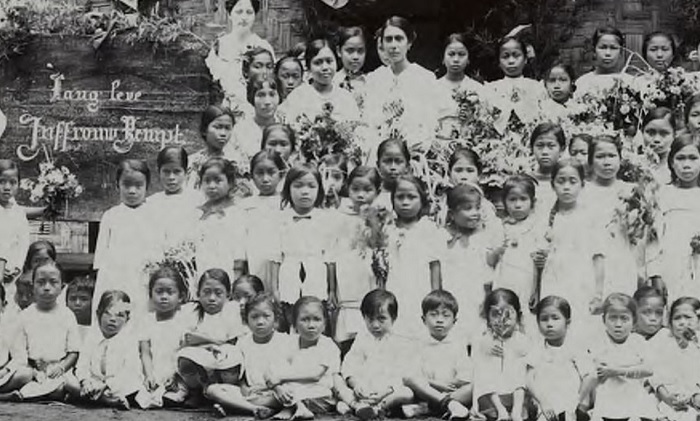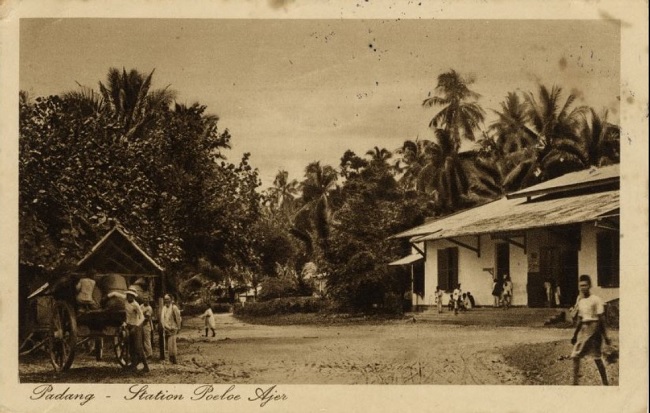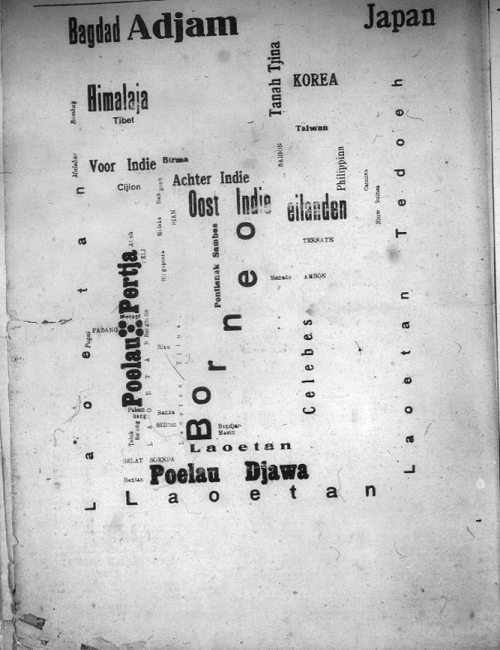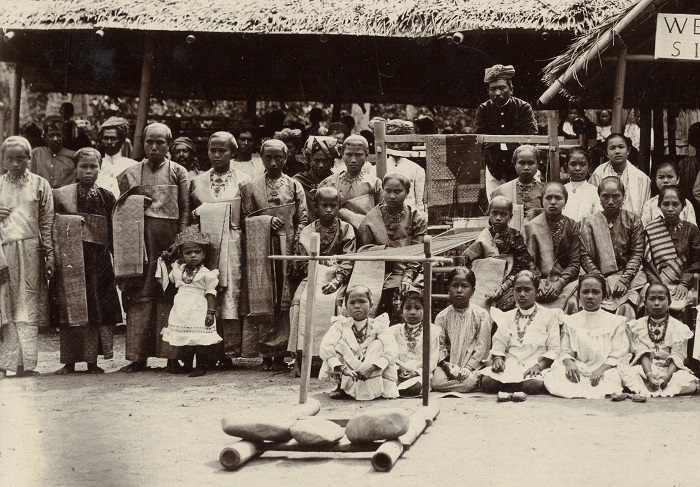Fragments of two girls’ life stories reveal the lived complexities and multiple meanings of being Malay in early twentieth century West Sumatra
One day in early 1915 in Padang, West Sumatra, a young teenager named Inah ran away from the property where she worked as a housemaid. Inah fled three kilometres by foot to a weaving school in Pulau Air. Community leaders who recorded her story framed Inah’s experiences in terms of her belonging to an exclusive community of Malays. This community was conceived of as both a product of deep connections between people on the west, east and south coasts of Sumatra to Borneo and across the straits to Malaya as well as a somewhat fluid marker of ethnic solidarity.
We can follow snippets of the lives of Inah and her classmates through Soenting Melajoe (Malay Headdress). This Malay-language women’s newspaper was published weekly in Padang between 1912 and 1921 and edited initially by two women: education activist Rohana Koedoes and journalist Zoebeidah Ratna Djoewita. Djoewita’s mother, Siti Amrin, taught at the Pulau Air weaving school from 1909. The weaving school and newspaper also shared a patron, Siti Amrin’s husband, Majoedin, who was known by his honorifics Datoe’ Soetan Maharadja. He was an influential journalist, datuak (Minangkabau customary leader) and politician who used these multiple platforms to advocate for a customs-centred vision of development.
Being Malay
Datoe’ Soetan Maharadja connected the newspaper to a network of associations that promoted girls’ education and a dual sense of being a person of alam (the Minangkabau world) and bangsa Melajoe (a member of the Malay people). In 1914, a group of prominent Padang businesspeople founded the Sarikat Oesaha (Entrepreneurs Association) with the intention of protecting Malay traders from Dutch and ethnic-Chinese market dominance. In the same year, Datoe’ Soetan Maharadja co-founded the smaller Sarikat Tenoen (Weaving Association), claiming to have been inspired by Boedi Oetomo’s project to forge a cultural nationalism through education on Java.
Together, these associations provided f.6 monthly scholarships to girls and women from vulnerable groups in Padang and Pariaman. According to the Weaving Association’s constitution, all scholarship recipients were to be Malay, which the association defined as upholding both the adat (customs) of their land and a general peace, being Muslim, as well as committing their efforts to ‘nurturing bonds of love’ and ‘hearts committed to helping one other’.
Despite its proclaimed commitment to the advancement of Minangkabau people, the Weaving Association also drew support from non-Minangkabau community leaders in Tapanuli and Padang Sidempuan in North Sumatra and Bengkulu, and their board included a young Betawi teacher. The first recipient of a scholarship was Inah, who identified as Betawi, a creole ethnicity that coalesced in in Indonesia’s ethnically diverse capital, Batavia, around the turn of the twentieth century.
These male community leaders who resided in various parts of northern and western Sumatra united based on a shared sense of being Malay. Indeed, the Weaving Association’s constitution drew the line of potential membership based on Malayness, stating: ‘if other people who love the Malay people seek to join the association, they will be deemed patrons [not members]’.
Scholarship on Malayness in colonial-era Indonesia has underscored the central role of the Malay-language press in fashioning commonality. The framing of Inah’s story in Soenting Melajoe illustrates how associations fashioned a sense of duty to provide social protection to members of this community and how these efforts were entwined with particular gender norms. According to the Weaving Association’s constitution, looking after households, cultivating a strong Islamic faith, good manners, knowledge of custom, and refraining from vulgarity and loquaciousness were the building blocks of Malay femininity.
Framing Inah’s life
In February 1915, Datoe’ Soetan Maharadja wrote a series of short articles in Soenting Melajoe about Inah’s alleged mistreatment by her employer and the school’s attempts to protect and uplift her. The articles framed Inah as both an agent and a girl requiring refinement to realise a middle-class Malay femininity.

Datoe’ Soetan Maharadja reported that Inah ran away from the household where she worked as a housekeeper or babu (nursemaid) and met a weaving school student who took her to the school. The next day, her former employer arrived to protest that Inah acquit her f.60 debt to him. The principal of the Pulau Air weaving school, Marah Sidi, reportedly retorted that it was impossible for a girl to accrue such debts and that she had been sold, which should be reported to police. Instead, the following day, Inah’s former employer arrived at the school with police, who took Inah to the nearby police station.
At the station, the Entrepreneurs Association president, Marah Baginda, assured police that the school would protect her from the man (meaning from sexual predation). Although Soenting Melajoe glossed over this in its report, noting only that Inah felt ‘ashamed’ of what had been happening to her, it was made clear by the newspaper Tjahaja Sumatera (Sumatran Light) which euphemistically reported that Inah’s former employer had ordered her to ‘massage his feet at night which enraged his wife.’
It is noteworthy that this case involved a man frequently identified as ethnically-Chinese in newspaper reports. Although this was a trope of reporting and literature at the time, Datoe’ Soetan Maharadja indirectly addressed this identity by repeatedly stating that Inah’s story was like the Hikayat Jahidin. Hikayat, a literary genre, is comprised of epic narratives about the past that are performed orally and include tales about individual experiences, as illustrated by the Hikayat Jahidin. With the rise of small printing houses, these more everyday-centred stories were frequently published in Malay, Dutch and local languages in the late nineteenth and early twentieth centuries. The Hikayat Jahidin tells the story of a teenage boy runaway tricked into working on a ship by a Chinese man in Singapore before his eventual escape and return to his village. These parallels thus can be seen to frame Inah’s story as an example of a wider racially-profiled threat rather than a case of abuse.
By framing her experiences as like those narrated in a hikayat, Datoe’ Soetan Maharadja scripted Inah’s escape into a long tradition of culturally-significant stories through which histories and norms are passed down in Malay cultures. While not adopting the structure of Malay hikayat, its evocation conveyed to readers that the story of Inah, often referred to as a ‘poor girl’, should be known among Soenting Melajoe’s mainly middle-class readership.
Datoe’ Soetan Maharadja’s account of Inah’s ordeal ends with a hopeful call echoing the newspaper’s cultural nationalist politics: ‘she may before have been a victim of injustice but now hopefully she will be free and able to learn’. No record remains, however, of Inah’s account of these events in her own words.

Five months after she began her education at the school, Datoe’ Soetan Maharadja reported that Inah had made significant progress after initial challenges. Inah’s hands, he wrote, initially ‘did not act prudently and broke the thread’. however, with continued ‘diligence and a feeling of ease when learning’ she had successfully made parts of jackets and trousers for sale. This provides a glimpse of how weaving schools and the newspaper envisaged Malay femininity as embodied and enacted in patience, diligence and refinement, with a sense of belonging crucial to flourishing.
Within six months, these associations had provided Inah with the means and safe space to learn livelihood skills and access formal government schooling. At the Pulau Air school, Inah learned alongside girls and women from West Sumatra and North Sumatra as well as at least one teenager from Aceh. Those under twelve years and above 35 years were exempted from the monthly f.0.10 fee.
Other scholarship recipients joined Inah at the school in 1915. One of them was an unnamed and recently widowed eighteen-year-old from West Pasaman whose family feared had no means to financially support herself following her husband’s death. This was thought to be a dangerous prospect because as Soenting Melajoe recorded: ‘everything bad could arise, damaging politeness and uprightness – prostitution.’ As in Inah’s case, the male associations who supported weaving schools positioned them as an instrument of education and moral instruction to protect (Malay) girls and women from perceived immorality.
Learning alongside Inah was teacher Siti Amrin and Datoe’ Soetan Maharadja’s young daughter, Retna Tenoen. In 1915, Retna was six years old and began to learn to weave ‘like it was merely playing’. In the next few years, her father wrote about her development, positioning Retna as a model of refined Minangkabau and Malay femininity: adept at Dutch and Malay word craft, polite, pious and skilled at weaving.
Retna writing her world
By early 1921, Retna Tenoen was an eleven-year-old student at both a Dutch native school and the Pulau Air weaving school. Through writing published in Soenting Melajoe, Retna explored her sense of self and belonging, including questions she had about skin colour. Retna looked outwards to think about what it might be like to be someone else.

While describing the above map, Retna wrote that people in Siam (present-day Thailand) and her Malay people shared a similar skin colour. This led Retna to argue that the desirability of skin colour was relative.
Perhaps the colour of molasses or white with red or turmeric is beautiful in the eyes of one people, whereas for people from China and Japan a desirable colour is that which is like their skin, and for people from Siam a desirable colour is that which is like their skin.
From Retna, we glimpse a way of encountering and considering difference but not structuring it hierarchically. This subjective viewpoint and inquisitive tone both cohered with and diverted from her father’s account of race in the same issue January 1921 issue.
Datoe’ Soetan Maharadja questioned the utility of racial categories as a way of viewing the world. He first listed that there were five ras (human races), which he equated with the Malay word bangsa (nationality or people): Mongol, Caucasian, African, Indian (by which he referred to indigenous peoples of North America) and Malay. For Datoe’ Soetan Maharadja, these categories were not stable but rather constructed. His definition of Malay was broad and reflected ethnographic research linking Sumatra with indigenous peoples in Madagascar and Taiwan. He also questioned how culturally salient race was as a collective identity, writing, ‘the term ‘Malay’ did not exist in the year of the Messiah, when a thousand Malays sailed from Poelau Pertja [Sumatra]’. Instead, he suggested founding solidarity on a history of mobility – of being from the land below the winds. Read together with Retna’s idea that the beauty was relative rather than universal, this account illustrates how race was thought of as contingent on history and an emerging emphasis on languages of geographically-based belonging.
Inah and Retna are parts of a much larger story about the many meanings of Malay in this network of print culture and associations in early twentieth century West Sumatra. The weaving school they attended illustrates intersections between a sense of racial identity and circumscribed female conduct codified by male community leaders which sought to produce and protect children, wives and mothers. At the same time, the Malay identity on which this school and these associations were based provided educational opportunities for girls like Inah, for whom justice and opportunity were often unattainable in the colonial-era Dutch East Indies.
The chapters of their life stories, traceable in Soenting Melajoe, demonstrate the lived complexity of racial perception and identity as an always-in-formation sense of an exclusive community and a contested lens for defining, encountering, and relating to self and other.
Bronwyn Anne Beech Jones (bbeech@student.unimelb.edu.au) is a PhD Candidate in History and holder of the Hansen Scholarship in History at the University of Melbourne.












